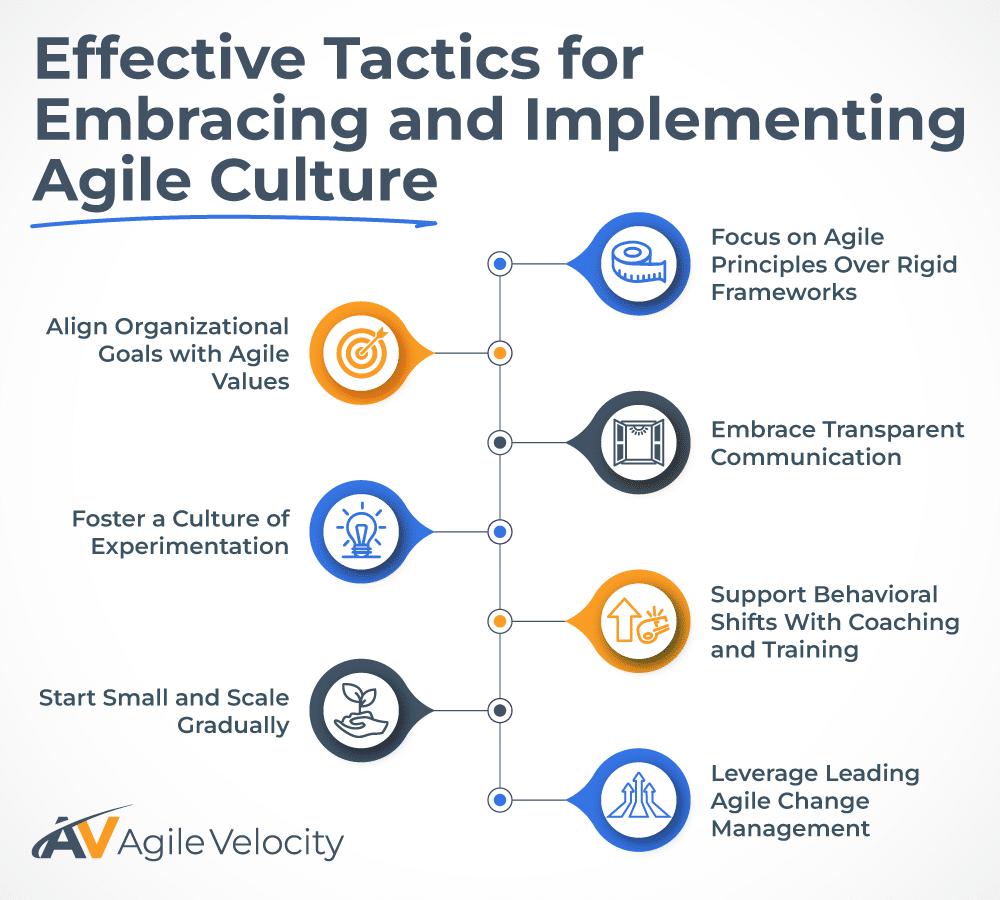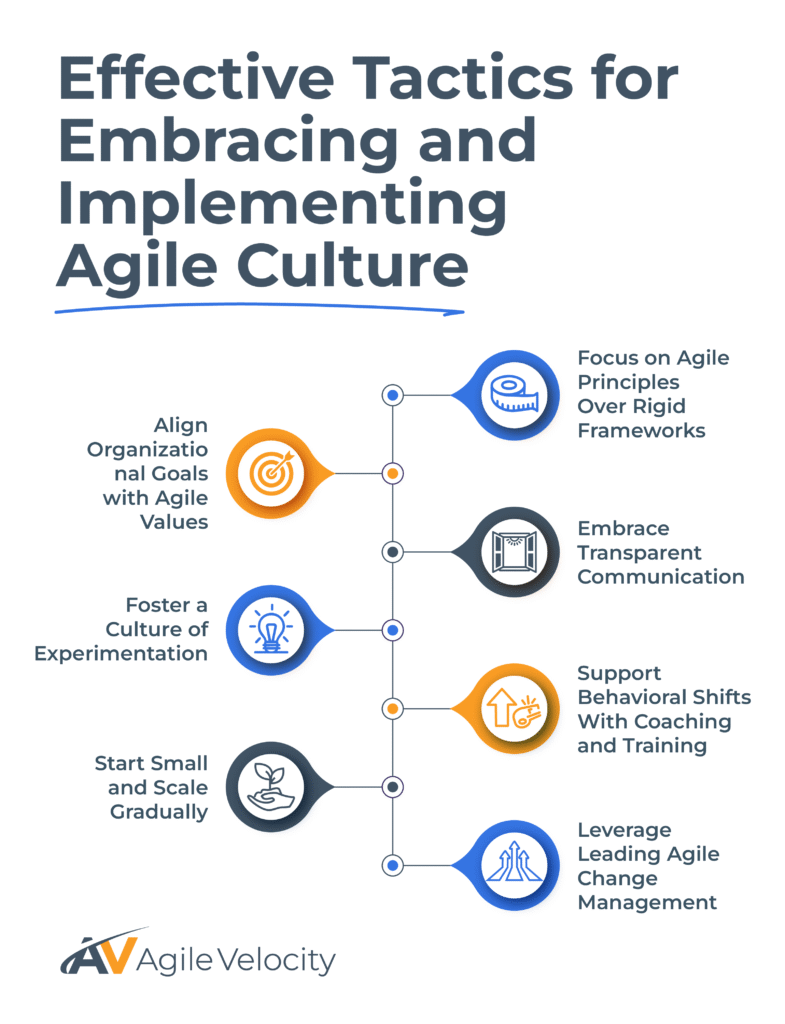Developing a strong Agile culture can redefine how organizations adapt, collaborate, and succeed. When nurtured effectively, this culture empowers organizations to adjust to shifting priorities, deliver customer value faster, and enhance employee engagement.
In this article, we explore practical strategies for building an Agile culture. We begin with a clear understanding of what Agile culture entails, examine the role of leadership in driving change, offer actionable steps for empowering teams, and conclude with ways to measure success during transformation.
Agile culture goes beyond implementing principles and frameworks. It requires aligning mindsets, behaviors, and values across all levels. By prioritizing collaboration, adaptability, and continuous improvement, organizations create a holistic environment that leads to enhanced productivity, innovation, and better outcomes. This mindset fosters ownership at the individual and team level, driving sustainable growth and resilience in changing markets.
Understanding Agile Culture
Adopting an Agile mindset is the foundation that enables organizations to adapt, collaborate, and innovate. Rather than relying solely on rigid processes, Agile culture emphasizes a mindset where team members work to understand and align around shared goals and are empowered to make decisions. Central to this culture is embracing experimentation, adaptability, frequent feedback cycles and pushing decision making to those closest to the work. Open communication and psychological safety encourage individuals to share ideas without fear of blame. With iterative work cycles and self-organizing teams, organizations learn from both successes and challenges, continually refining processes.
When an Agile culture is in place, collaboration flourishes. Teams can experiment with new techniques, gather quick feedback, and rapidly integrate lessons learned. This environment bolsters creativity and supports a culture of continuous improvement, ultimately fueling innovation and delivering better outcomes for customers.
Because Agile culture hinges on engagement, organizations often restructure how they measure success. Instead of focusing only on quantitative targets, they also look at team health, the frequency of experiments, and the overall ability to respond to new opportunities or disruptions. This balanced view bridges the gap between immediate objectives and long-term sustainability and growth.
The Importance of Agile Leadership in Driving Culture
Agile leadership is essential in shaping and sustaining an Agile culture. It cannot be overstated. Leaders must demonstrate Agile principles in their actions, setting the tone for behaviors across the organization. They encourage teams to adapt, learn, and innovate, even when results are uncertain. This example-driven leadership style fosters authenticity and transparency, enabling deeper collaboration and trust.
Fostering Transparency and Collaboration
Effective leaders share information openly and frequently, reducing uncertainty and enabling informed decision-making. By inviting input from team members, they harness collective intelligence and spur creative problem-solving. Frequent dialogue also aligns everyone around common objectives, minimizing miscommunication.
Creating Trust Through Psychological Safety
Leaders who treat failures as learning experiences cultivate a safe environment. Team members gain confidence in proposing innovative ideas, knowing that honest attempts to improve will be valued. This approach prevents blame culture and enhances accountability across the organization. True agile leaders know that the only real failure occurs when people give up.
Empowering Teams and Maintaining Accountability
Agile Leaders focus on setting clear objectives and give teams discretion over how to achieve those objectives. This autonomy challenges teams to innovate,learn and take ownership of the problems they are working to solve. Leaders remain available to remove roadblocks or clarify priorities, striking the right balance between support and accountability.
Navigating Change with Resilience
Rapid market shifts and new technologies often require leaders to pivot strategies. Agile Leaders communicate often, adapt plans while making sure everyone understands in very clear terms why plans are changing), and provide resources that sustain team morale. By encouraging flexibility and resilience, they help teams handle evolving demands without losing clarity or momentum.
Empowering Teams to Thrive in an Agile Environment

Empowered teams lie at the heart of an Agile culture. When teams understand the purpose behind their work—and are trusted to deliver—they’re more motivated to contribute to shared goals. Empowerment involves creating self-organizing teams, promoting continuous learning, and ensuring collaboration remains integral to daily work.
Building Self-Organizing Teams
Agile environments encourage teams to self-organize around their skills and interests. This structure enhances motivation because team members choose how to address objectives. By removing layers of approval, teams act faster, solve problems more efficiently, and take ownership of outcomes.
Cultivating a Mindset of Continuous Learning
Teams should have the freedom to experiment with new tools or techniques. Both successes and failures become opportunities to learn. This approach encourages sustainable progress, as teams refine their methods incrementally rather than waiting for large-scale changes. Leaders make it clear that continuous learning is an expectation and not an option.
Strengthening Collaboration Through Clear Communication
Short, focused discussions and openness about challenges let teams respond quickly to issues. Using digital platforms can further boost collaboration, especially for distributed or hybrid teams. This transparency encourages knowledge sharing and makes it easier to align everyone on short-term goals.
Uniting Teams Around Shared Goals
When individuals see how their tasks contribute to broader objectives, they’re more likely to stay engaged and motivated. Frequent re-alignment sessions build a sense of purpose, strengthen accountability, and help teams work together with minimal friction.
Practical Approaches for Transitioning to an Agile Culture
Transitioning to an Agile culture demands a flexible mindset. Success is not just about incorporating new Agile Methodologies; it involves aligning the organization’s goals, plans, and behaviors with Agile values. This shift usually calls for leadership commitment, redefined roles, and open dialogue about expectations.
Focus on Agile Principles Over Rigid Frameworks
While frameworks such as Scrum and Scaled Agile Framework® (SAFe®) provide useful structures, meaningful progress depends on embracing core Agile values like adaptability, collaboration, and customer focus. It’s more effective to tailor frameworks to organizational needs rather than rigidly following every rule.
Align Organizational Goals with Agile Values
Connecting Agile practices to bigger business objectives is key. Leaders should clarify how customer-centricity, innovation, and adaptability support strategic imperatives. This clarity encourages buy-in at all levels and fosters a smoother adoption of any Agile practices.
Hire the Right People
Evolving the way employees and leaders think can take an extended amount of time. New hires can be a great way to accelerate the process. When hiring a new person, use it as an opportunity to find someone who is used to an agile culture and will bring it with them to your company. This gives others an example of what agile looks like and how it works.
Set Clear Expectations
All too frequently, employees of companies moving to agile practices behave as though it is optional for them. Leaders need to set clear expectations that everyone will be participating. When people hear the message from leaders and peers the shift to an agile culture will happen more quickly and smoothly.
Embrace Transparent Communication
Open communication channels help break down silos. Frequent updates, organization-wide sessions, and collaboration tools keep everyone informed and aligned on changing priorities. This visibility ensures less confusion and more autonomy in decision-making.
Foster a Culture of Experimentation
Agile Transformation thrives on rapid learning and quick course correction. Running small pilot projects builds momentum, as teams can implement lessons learned before scaling up. Rewarding thoughtful risk-taking helps counteract fear of failure, paving the way for ongoing improvements. Leaders can help by creating the space and providing “air cover” for innovative activities.
Support Behavioral Shifts With Coaching and Training
Coaching and targeted training reinforce the mindset needed for Agile. Teams may also explore certifications to build foundational skills. Additionally, Agile Coaching offers hands-on guidance to embed new ways of working, and Agile Training sessions help teams develop shared terminology and techniques.
Build on the Success of Small Wins
Kicking off with smaller or pilot projects allows teams to refine processes and validate Agile practices. Early successes build confidence and highlight tangible benefits, motivating broader organizational adoption. This steady expansion encourages sustainable change.
Leverage Leading Agile Change Management
Many organizations also rely on Leading Agile Change Management to navigate cultural shifts. Through structured support, teams can more easily adapt their behaviors, align around new objectives, and overcome obstacles that arise in early stages of transformation.
Tools and Techniques to Support Agile Transformation
A robust Agile Transformation often relies on targeted tools and expert guidance. These resources bring clarity, track progress, and help organizations adapt when unexpected challenges arise.
Agile Coaching and Training
Expert coaching helps teams apply Agile principles in real-world scenarios, adapting frameworks to meet specific needs. Tailored training builds shared vocabulary and core skills, reducing friction across departments. These sessions deliver immediate benefits that bolster both team performance and cultural alignment.
Lean Portfolio Management and Tailored Solutions
Lean Portfolio Management connects everyday tasks with high-level strategic goals so that initiatives deliver maximum value. Other specialized solutions, such as Return to Office Events, enhance collaboration in hybrid or remote setups. For organizations seeking scalable structures, SAFe Agile Transformation offers a phased approach.
Path to Agility® Navigator: A Strategic Ally
Path to Agility® Navigator equips teams and leaders with actionable data to assess current capabilities and identify improvement areas. By visualizing progress in leadership alignment, process maturity, and team collaboration, it provides clear direction for ongoing enhancement.
Path to Agility Navigator offers a broad view of the Agile journey. By examining factors like leadership alignment, process maturity, and team engagement, it pinpoints where to focus improvement efforts. This clarity maintains momentum and helps teams target their priorities effectively.
Addressing Common Challenges in Building an Agile Culture
Implementing a culture of continuous improvement is rarely straightforward. Misalignment, communication challenges, personnel issues and transformation fatigue often arise. Proactive strategies help organizations tackle these roadblocks and increase the likelihood of successful outcomes.
Tackling Resistance to Change
Uncertainty can lead to opposition, especially when new processes seem disruptive. Clarifying the advantages of Agile—for instance, faster feedback loops or improved autonomy—can help lessen concerns. Demonstrating success through low-risk pilot projects also fosters trust and eases transition.
Breaking Down Silos and Encouraging Collaboration
Rigid departmental structures can hinder information sharing. Encouraging cross-functional collaboration, open discussions, and transparent tools eliminates many of these barriers. When teams understand how their tasks affect the bigger picture, they can coordinate efforts more effectively.
Overcoming Transformation Fatigue
Sustaining momentum during ongoing changes can be challenging. Recognizing individual achievements, holding feedback sessions, and showcasing tangible benefits—such as quicker customer response times—helps maintain enthusiasm. Regularly revisiting objectives also reminds teams why change matters. A disciplined and regular change management practice can also help reduce fatigue.
Avoiding Over-Reliance on Frameworks
A successful Agile culture thrives on Agile values and principles, not on following a single framework to the letter. Organizations should adapt practices to fit their realities rather than forcing one-size-fits-all solutions. Consistent review ensures that frameworks remain supportive rather than restrictive. Keep people focused on the desired outcomes with agile as means to get there. It’s never about “agile.”
Shifting from Traditional Structures to Agile Ways of Working
Moving away from hierarchical chains of command toward Agile ways of working can transform both speed and quality of decision-making. Agile organizations clarify outcome-focused goals and grant teams the freedom to collaborate and act swiftly. This shift underscores the value of a comprehensive Agile Transformation that helps organizations pivot quickly and align around new market realities.
Evolving Beyond Rigid Hierarchies
Traditional, top-down structures often slow down responses to market shifts. Distributing authority empowers teams to adapt quickly. Setting clear objectives and constraints ensures alignment while allowing thoughtful autonomy.
Redefining Roles to Enable Collaboration
Agile Transformation doesn’t remove roles—it repurposes them to champion collaboration. Roles like Scrum Master and Product Owner focus on facilitating teamwork and prioritization. Teams benefit from shared responsibility and a greater sense of ownership over the product or service.
Measuring Success in Agile Culture Transformation

Metrics—both quantitative and qualitative—help organizations evaluate how well Agile culture is taking root. Traditional measurements such as velocity and lead time can show efficiency, while feedback on collaboration or psychological safety provides insight into cultural shifts.
Identifying the Right Metrics
Select metrics that align with both strategic objectives and people-focused outcomes. Team satisfaction, customer feedback, and cycle times often blend to give a complete picture of an organization’s agility.
Measuring Collaborative Success and Value Delivery
Indicators such as faster time-to-market, improved customer satisfaction, and an increase in innovative ideas highlight the benefits of an Agile culture. Transparent metrics validate ongoing efforts, reinforcing that continuous improvement delivers value across teams and customers alike.
Sustaining Agile Excellence Over Time
Establishing an Agile culture calls for continuous effort and patience. Organizations must regularly revisit goals, celebrate milestones, and invest in their people. Periodic refresher sessions on collaboration, feedback, and adaptability lay the groundwork for ongoing improvements.
Communities of practice can add structure to knowledge sharing, encouraging peer-to-peer engagement. In such forums, team members exchange practical solutions, learn from varied experiences, and embed new ideas into daily work. Recurring retrospectives and planning events help detect issues, allowing teams to adapt before problems scale. These small adjustments, made repeatedly, nurture growth and innovation.
Leveraging Technology for Continuous Improvement
Technology streamlines collaboration and boosts agility. Real-time dashboards can flag bottlenecks, enabling swift course corrections. Digital platforms also foster transparency, with teams sharing daily updates, tracking tasks visually, and coordinating rapidly around evolving customer demands. These tools reinforce Agile values by promoting flexibility, openness, and constant feedback.
Beyond process visualization, analytics capabilities can transform the way teams assess risks, measure customer satisfaction, or budget for iterative development. By tying these insights to Agile principles, organizations become better at predicting outcomes and adjusting plans.
Encouraging Peer Learning and Mentorship
Peer learning and mentorship programs maximize knowledge sharing. More experienced Agile practitioners can guide colleagues, reinforcing core concepts and fostering a strong sense of community. Regular discussions or skill-building sessions help individuals acquire new capabilities. This approach accelerates problem-solving, reduces reliance on external resources, and strengthens overall engagement.
Mentorship also supports professional development and increases retention. When team members feel their growth is a priority, they’re more likely to invest in the organization’s goals. This creates a self-reinforcing system, where expertise spreads organically, fueling further innovation.
Driving Continuous Improvement and Innovation Through Agile Transformation
Cultivating an Agile culture hinges on shifting mindsets, promoting consistent collaboration, and embedding continuous improvement in everyday work. When leadership champions transparency and empowerment, teams feel motivated to innovate and drive meaningful outcomes. Incremental changes, frequent feedback, and clear metrics sustain agility over the long haul.
Whether you’re beginning your journey or refining an existing culture, Agile Velocity can help you move forward. Our services provide the guidance and support leaders and teams need. Explore how we can propel your Agile Transformation and strengthen your Agile culture today!





